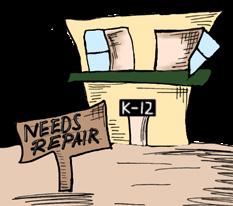

“PAGE over 18 million junior high school graduates are considered “functional illiterate”





“PAGE over 18 million junior high school graduates are considered “functional illiterate”


Among all these new things one old problem still haunts learnerstransportation.

Mardave M. CHULLAYAN
chool Parent-Teachers Association (SPTA) officers backed the school administration’s call to make wearing school uniforms mandatory during the Quezon National High School 1st SPTA meeting today, June 30.
Addressing the parents, the school principal, Dr. Menalyn A. Salvador, highlighted that there is a need for school identity due to recent incidents of outsiders entering the school.
“Mas madali nating makilala kung sino ang student ng QNHS kung naka-uniform sila,” she
said.
In a survey conducted by The Range, 84.42% or 233 of the 276 interviewed parents agreed. Among the reasons for parents’ agreement during the survey were the encouragement of discipline and the promotion of school identity, as students will be easily
identified inside and outside the school.
The target implementationof the mandatory wearing of uniform will be on July 14.
The election of Homeroom PTA officers were also conducted prior to the general meeting.
COLLECTIVE EFFORT. Dr. Menalyn A. Salvador appeals to parents and stakeholders to help encourage learners to wear school uniforms this school year during the 1st School Parents-Teachers Association (SPTA) General meeting last June 30.
“Pakiusap po sana natin na pagtulungan natin mag-convince na sana by this school year, mag-uniform na po sila,” she said.
Jevan R.
Funded mainly through School Parents and Teachers Association (SPTA) contributions, the newly constructed Senior High School stage is now functional.
With a total expense of P85,408, including voluntary works transposed to monetary equivalent, the stage, which began construction last April 2025, was completed in the first week of the current school year.
Aiming to enhance the overall conduct of school events, the school administration, led by the school principal Dr. Menalyn A. Salvador and Senior High School Head Teacher Marie Joy
C. Reyes, included the project in the school budget.
A total of P42,400 from the Maintenance and Other Operating Expenses (MOOE) was used to purchase steel, cement, and roofing materials. Meanwhile, parents of Senior High School learners contributed a total of P26,408.
Aside from monetary support, parents and other stakeholders volunteered their time and effort to help build the stage, with their unpaid labor estimated to be worth around P12,600.
Additionally, Senior High School teachers donated P4,000,

which was used mainly for the snacks and lunch of the workers.
The stage was utilized for the first time during the flag ceremony last June 30, 2025, providing a more spacious and elevated platform for school programs and announcements.
With the new stage in place, school events such as weekly flag ceremonies, learner performances, culminating activities and other assemblies are expected to be conducted in a more organized and structured manner.
With an opening program held across the three campuses of Quezon National High School, school year 2025-2026 officially opened last June 16.
In her message, School Principal Dr. Menalyn A. Salvador welcomed all learners, especially the Grade 7 students who are “starting a new and exciting chapter in their educational journey.”
She also challenged the learners to embrace the school year with enthusiasm and a genuine desire to learn while making the most of opportunities.


“I challenge each one of you to embrace this school year with enthusiasm and a genuine desire to learn. Make the most of every opportunity—to gain knowledge, wisdom, friendships, and meaningful experiences,” she said.

Dr. Salvador reminded learners not to be dismayed by challenges that may arise in academics and life.
“Challenges in academics and life may arise, but do not be dismayed. Each challenge is a chance to grow stronger and wiser.”
As of June 30, the number of enrolled students has reached 1,227.
The opening programs were led by the Supreme Secondary Learner Government (SSLG) and Barkada Kontra Droga (BKD) officers.
The Department of Education
(DepEd) officially started school year 2025-2026 last June 16, marking the successful return of the traditional JuneMarch school calendar.
This shift addresses years of concern over the previous schedule, which exposed learners and teachers to extreme heat. This decision is not just timely but also a beneficial move for the whole educational system.
Thoughthe change of schedule during the COVID-19 pandemic was a necessary, the school year extends into the peak summer months of April and May which brought new challenges to both learners and teachers. They found themselves enduring extreme
In a survey conducted by The Range, 8 out of 10 learners and 9 out of 10 parents agreed with the transition of the school year back to June.

On a recent news, Kabataan Party-list Rep. Raoul Manuel said the K-12 program implementation made the existing educational problems worse instead of solving them.
heat in overcrowded classrooms, with temperatures often breaching safe limits. The heat not only caused discomfort but also led to class suspensions, health concerns, and decreased productivity.
Now, with classes starting in June, the school year ends before the hottest months arrive. This timely change provides students and teachers with a more comfortable and focused learning environment. It also allows families to enjoy the summer break without the pressure of ongoing classes or deadlines.
Indeed, this transition is rooted in common sense. It acknowledges our climate, and prioritizes our learners. While the change may not solve all the challenges of the Philippine education system, it is a meaningful step toward to a more learner- centered, and adaptive academic framework.
out of 255 parents agree out of 365 learners agree



“Hinabaan ‘yung number of years ng pag-aaral ng mga estudyante, tapos ngayon ang pinoproblema paano magti-trim ng subjects, paano magti-trim ng class hours. Kaya mas mabuti pa, ibasura na ng susunod na Kongreso ang K-12 program,” Manuel told ABS-CBN News.
This move can actually cause more trouble not only in the Department of Education, but to the whole nation.
The K-12 curriculum in the Philippines was first implemented during the 2012-2013 academic year. It covers Kindergarten and 12 years of basic education. The program aims to provide sufficient time for mastery of concepts

Princess Heliarie S. BAQUIRAN
and skills, develop lifelong learners, and prepare graduates for tertiary education, middle-level skills development, employment, and entrepreneurship. This was also created for Filipinos not only to be nationally but also internationally competitive.
Looking at the performances of students in literacy and numeracy, removing the K-12 curriculum will only worsen the possibility of students to graduate and land a stable job.
During a Senate Basic Education Committee hearing on the results of the 2024 Functional Literacy, Education and mass media survey (FLEMMS), it was revealed that over 18 million junior high school graduates are considered “functional illiterate”learners who have low comprehension and understanding.
This isn’t just a simple matter. This concerns the future of the students and even the economy of our country. Yes, the curriculum might have lengthen the time of studying to match with the other part of the world, because Filipino learners need it more than them. As I have observed, even senior high learners are having a hard time to comprehend or even construct simple sentences.
If we remove the K-12 curriculum in our education system, learners will graduate faster. But the thing is, most of them will not get the competencies they need for college.

Editor-in-Chief Princess Heliarie S. BAQUIRAN
Associate Editors Katrina Cassandra L. CACATIAN
Khaye Marie C. TUGADE
Managing Editors Adrian J. BALANCIO
Desiree O. SANSANO
News Editor Roselyn A. RAMOS
Chief Layout Artist Jevan R. PATUBO
Chief Graphics Artist Charlene Jhoy S. ORTIZ
Chief Cartoonist Christian V. ALINDADA
Senior Writers Charlotte P. BERNARDO
Princess Keith G. ILA
Frances Anika L. LEAL
Senior Cartoonists Froilan B. BLASI
Prince Genesis A. GENINE
Writers | Fitch Brian M. ALEXANDER, Mitch Fei M. ALEXANDER, Jedi S. CARGANILLA, Mardave M. CHULLAYAN, Marian Shanibri T. DE GUZMAN, Angel Ann G. DULAY, Leanna Jhielle F. FERNANDEZ, Chadly H. LUCENA, Ruein Grace DC. MANEJA, Chustien Charl A. ORGANIS, Lizz Rhowie Alexie P. PACHECO, and Jessica G. TILITILI
Cartoonists | Charlyn S. JIMENEZ and Angel M. ILA
Phototojournalists | Shayne C. ESPIRITU, Alyssa Kate M. EUGENIO, Francesca Mae MONTERO, Xyra C. PANIT, and Annabelle N. TIO-AN
Layout Artist | Rhianne P. DACANAY and Kind P. DIPANYO
School Paper Advisers | Jefferson C. LAGUNILLA, Teacher II and Reyma Rose P. LAGUNILLA, Teacher II
Consultants| Marie Joy C. REYES Head Teacher III, Chona Joy S. SABADO Head Teacher III, Norma D. VICENTE Head Teacher III, and Menalyn A. SALVADOR EdD Principal III
The quality of education in the Philippines have been declining over the years, and that’s a reality we cannot ignore.
With the help of the K-12 curriculum, we may still be able to enhance our basic education by aligning it with global standards. With it, literacy and numeracy can be improved, learners will be work ready, and has a greater chance of surviving.
Remember, it’s not the curriculums fault, it’s the implementation. If it’s broken, let’s fix it. Not remove it.
Adrian J. BALANCIO
Iwas losing my patience waiting for my ride to school. It was the first day of my senior high school journey. I looked at my phone — 6:03 a.m. It was still early, but it’s never wise to underestimate bad luck. Since we live seven kilometers from school, the 10 to 15-minute commute is a daily struggle.
Time passed, and guess what? It was already 6:33, and I was still waiting for a tricycle to school. It wasn’t that none were passing by — there were — but already full. The sun began to peek over the horizon. The heat slowly crept in, but there I was, still hoping for some luck.
It felt like an eternity, but finally, I got a ride — a tricycle with barely any space left. What’s meant to carry five
passengers had crammed in seven.
“Finally!” I sighed — the first of many for this school year. As I hopped inside, I couldn’t help but think how troublesome it is to get a ride to school. Sometimes, it’s because of picky drivers and crowded vehicles, but most of the time, it’s the undeniable lack of transportation.
As the tricycle traveled the familiar route, my mind wandered to the past — to the many times I was late due to transportation issues. This is the problem for learners like me who live far from school. There are few options. There are jeepneys that can carry more passengers, but they’re packed to the top. Tricycles travel from different barangays too, but if you’re often picked up last, chances are they’re
Charlotte P. BERNARDO
Ialready full. Hiring a tricycle on your own is an option — but it’s expensive.
When the tricycle stopped in front of the New Building Campus, where all of us needed to get off, my wandering mind returned to the present. I paid my fare and began the five-minute walk to the senior high school campus.
It was two minutes to seven. I still had time to look around and chat a bit with my friends before the 7:15 flag ceremony. Did they enroll in the same strand as me? Some did.
As the
flag ceremony and welcome program began, I looked around at my new environment. A new campus. New classmates. New teachers. But among all these new things, one old problem still haunts learners - transportation.

t’s June 16—the official start of classes this year. The school year was moved earlier to avoid the intense heat usually experienced in April and May. This change also marks the return to the traditional June-to-March academic calendar, which had been adjusted during the pandemic.
My school supplies and bag are ready, but I’m not sure if I am. It’s only 6:00 a.m., and I’m on my way to school, wondering what will happen with my new section, which I still don’t know. I don’t even know if I feel excited, sad, nervous, or maybe even mad.
When I entered our school, I wandered trying to search my new section and classmates along the way.
I looked at my previous classmates and they’re hugging each other. Everybody’s feeling down since they still want to be in their own circle of friends. That is when it struck me. What we’re afraid of last year is now a reality — heterogeneous sectioning.
Last year, I belonged to a homogeneous section that was performing well academically, while the other sections remained
heterogeneous. However, some students from other sections felt it was unfair, especially since we often won in competitions. This year, things are different.
This school year, the administration decided to revert to heterogeneous sections. In terms of academic, all sections are equal now. The sections have been reorganized to make them more balanced. I can’t help but feel unsure about how this new setup will affect my performance.
New adviser, new classmates. As expected, some faces are familiar, while others are not. Questions run through my mind— what if my sense of humor doesn’t match theirs? What if we don’t get along? I still feel more comfortable with my previous classmates. Maybe it’s just me. But maybe, just maybe, I’ll get used to it.

“New adviser, new classmates. As expected, some faces are familiar, while others are not. Questions run through my mind—what if my sense of humor doesn’t match theirs? What if we don’t get along? I still feel more comfortable with my previous classmates.
/from page 04
The main office is also located there. The second is the New Building, home to the Grade 9 and Grade 10 students. Lastly, there’s the Senior High School Building, where Grade 11 and Grade 12 students attend classes.
As a student who lives near the school, I consider myself lucky. I don’t have to worry about transportation. I can even wake up at 7:00 AM and still make it to class on time. Back when I was in Grade 10, I always walked to the right side of our house to reach the New Building. Now, my path takes me to the left. I once thought about transferring, but for some reason, I stayed.
Looking back, staying was the right decision. It made my senior high journey much easier. No more early wake-ups.
No more rushing for rides. I can go home easily.
Still, being in a new environment feels different. I chose the Humanities and Social Sciences (HUMSS) strand, and on the first day, I already wanted to shift. I doubted myself and felt unsure if I could handle it. Yet I’ve come to realize that there’s no turning back. I have to face the challenges and adjustments waiting for me.
Many of my friends from junior high have transferred, and adjusting without them has been tough. There are also many new rules I’m not used to, but I know I’ll get the hang of them. With QNHS divided into three separate buildings, adjusting can be harder than expected—but not impossible.


Katrina Cassandra L. CACATIAN
As part of strengthening earthquake readiness among learners, the Quezon National High School community participated in the Second Quarter Nationwide Simultaneous Earthquake Drill (NSED) last June 19, across its three campuses.
Personnel from the Municipality of Quezon’s Bureau of Fire Protection (BFP) and the Municipal Disaster Risk Reduction and Management Office (MDRRMO) observed the drill at the Senior High School (SHS) campus.
During the post-evaluation, SFO4 Analin Mallari, chief operations officer of BFP Quezon noted significant improvement compared to previous drills.

EARTHQUAKE READY. Learners in the New Building campus covers their head as they go out the school building during the 2nd quarter National Simultaneous Earthquake Drill last June 19. Chadly O. LUCENA
To save electricity and reduce energy consumption, the Quezon National High School (QNHS) Youth for Environment in Schools Organization (YES-O) resumed the energy conservation program which involves turning off of electric fan and lights during the first period, break time, lunch and cleaning time in the afternoon starting June 30.
“Para makatipid tayo ng kuryente kase umabot tayo ng 8k, so sa pag tuturn off ng light sa first hour, hindi naman super init hindi kailangan ng electric fan kaya pinapapatay during break time - wala namang tao sa room and lunch time. Makatutulong tayo makapag save ng energy hindi lang sa environment natin kundi pati sa school,” Harlene M. Gonzales, YES-O Adviser in the Senior High School campus said in an interview.
During the flag ceremony in the New Building campus, Phoebe Gil G. Pimentel, YES-O adviser, announced various offenses for sections who will violate the rule. For the first and second offense, all learners in the section who incurs the highest violation will segregate waste. Aside from segregating waste, for the third offense, learners will pay 10 pesos each.
In a survey conducted by The Range, learners in general agreed with turning off lights and fans during the first period and recess but many
FEATURES
disagreed with it during lunch.
Learners who eat lunch inside the classroom said that the temperature is not bearable anymore during this time.
Gonzales acknowledged that it is indeed hot inside the classroom during lunch break.
“Yes! Mainit talaga tuwing tanghali pero part po ng energy conservation program ang pag-patay ng ilaw at electric fan tuwing lunch break para makatipid sa kuryente at makatulong sa kalikasan,” she said.
To ease the heat, Gonzales suggested that learners who stay inside the classroom during lunch may open the windows or move to a cooler place.
“Do’n sa time din kasi na yun, pwede tayo makatulong tutal break din, malaki din ang naitutulong natin sa pagbabawas ng energy waste,” Gonzales added.
YES-O officers monitors the implementation of the program by checking classrooms in the scheduled time.
“Kumpara sa na-observed namin noon, malaki ang naging improvement ninyo,” she said.
She also emphasized how learners stayed calm during the drill which is very important in real scenarios.
However, SFO4 Mallari reminded the learners that there is still room for improvement particularly in the response time after the bell stops ringing.
“Medyo mabagal. Once nag-stop ang bell, immediately na lalabas,” she advised.
MDRRMO representative Jeanne D. Alcantara also commended the conduct of the NSED and convinced the learners to join first aid teams.
Learners and school personnel from both Main Campus and New Building (NB) Campus also participated in the nationwide drill.
NB learners and personnels also simulated various earthquake related scenarios. The use of fire extinguisher was likewise demonstrated, allowing both learners and teachers to gain handson experience in fire safety.
New people. New environment. New opportunities. For most people, it’s just another ordinary day—but for students, it’s THE day. The day classes begin. And honestly, it came earlier than we expected.
After a two-month summer vacation, we’re back. June now marks the official opening of classes for many public and private schools, starting earlier this year due to schedule adjustments made by the Department of Education (DepEd).
Quezon National High School has three main
buildings. The first is the Main Campus, where Grade 7 and Grade 8 students are housed. The main office is also located there. The second is the New Building, home to the Grade 9 and Grade 10 students. Lastly, there’s the Senior High School Building, where Grade 11 and Grade 12 students attend classes.
Quezon National High School has three main buildings. The first is the Main Campus, where Grade 7 and Grade 8 students are housed.